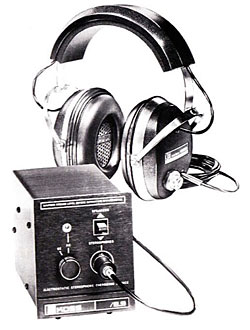| Columns Retired Columns & Blogs |
I really love reading JGH's stuff - and this is a gem about an extraordinary product. But! I can't imagine saying this: "However, since most samples of the ESP-9s sound just a shade up at the high end and a shade down when using the 9' extension, this raises the possibility of getting perfectly flat response from them by using half the length of the extension (by cutting it and reconnecting one plug to the shortened end). We did not investigate this further, but see no reason why it would not work." in one of my reviews....hehehehe
 The top-of-the-line model from America's leading headphone manufacturer, these are bulky, heavy, very business-like in appearance, and very, very good.
The top-of-the-line model from America's leading headphone manufacturer, these are bulky, heavy, very business-like in appearance, and very, very good.






































